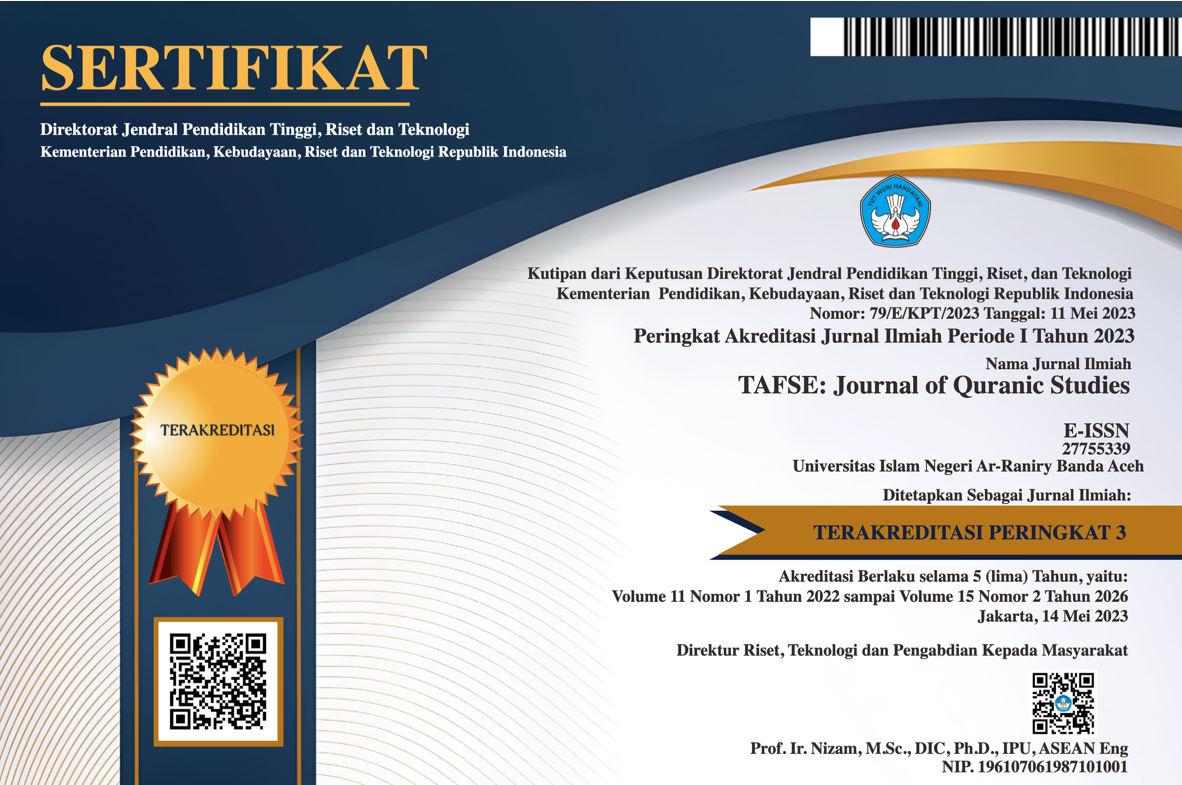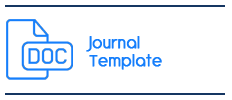Intertextuality in the Tafsir Ya Ayyuha Al-Lazina Amanu by Syaikh Abdul Latief Syakur
DOI:
https://doi.org/10.22373/tafse.v9i2.26220Keywords:
Intertextuality, Tafsir, Ya Ayyuha Al-Lazina Amanu, Syaikh Abdul Latief Syakur, Julia KristevaAbstract
This study examines the intertextual approach of Syaikh Abdul Latief Syakur in his Tafsir Yā Ayyuha Al-Lażīna Āmanū, focusing on how he engages with classical Islamic sources and contextualizes them within his socio-historical milieu. The library research method includes codicological analysis of the manuscript to examine its physical attributes, while also analyzing the textual connections between Tafsir Yā Ayyuha Al-Lażīna Āmanū and its primary intertextual sources. Key findings highlight three main intertextual strategies in Syaikh Abdul Latief Syakur’s work: transformation, where classical interpretations are adapted to address ethical and linguistic nuances; expansion, where Qur’anic terms are recontextualized to reflect universal Islamic principles; and parallelism, which identifies recurring themes and structures across verses to illustrate the coherence of Qur’anic discourse. The study also explores the use of primary sources, including Anwār al-Tanzīl wa Asrār al-Takwīl by al-Baidlawi, Tanwīr al-Miqbās min Tafsīr Ibn ‘Abbās, and references to the Torah, illustrating how these works informed his interpretations. By integrating these sources with his unique scholarly perspective, Syaikh Abdul Latief Syakur provides a tafsir that bridges classical traditions and contemporary concerns.
Downloads
References
Affani, Syukran. Tafsir al-Quran dalam sejarah perkembangannya. Edisi pertama. Rawamangun, Jakarta: Prenadamedia Group, Divisi Kencana, 2019.
‘Ālī al-Ṣābunī, Muhammad. Studi ilmu Al-Qur’an. Damaskus: Maktabah al-Ghazali, 1991.
Al-Kharabsheh, Aladdin. “Qur’an-Related Intertextuality: Textual Potentiation in Translation.” International Journal of Applied Linguistics and English Literature 6, no. 6 (1 September 2017): 195. https://doi.org/10.7575/aiac.ijalel.v.6n.6p.195.
Altakhaineh, Abdel Rahman M., Marwan Ali Jarrah, dan Marzoug N AlSulayyi. “Discourse Meanings: An Application of Intertextuality Perspective.” International Journal of Linguistics 6, no. 2 (26 Maret 2014): 85. https://doi.org/10.5296/ijl.v6i2.5078.
Arifin, Mochammad, dan Mohammad Asif. “Penafsiran Al-Qur`An Kh. Ihsan Jampes; Studi Intertekstualitas Dalam Kitab Sirāj Al-Ṭālibīn.” AL ITQAN: Jurnal Studi Al-Qur’an 1, no. 2 (15 Juli 2015). https://doi.org/10.47454/itqan.v1i2.23.
Asnita, Roma Nur. “Kajian Intertekstual Dalam Novel Ayat-Ayat Cinta Karya Habiburrahman El Shirazy Dengan Novel Dzikir- Dzikir Cinta Karya Anam Khoirul Anam,” t.t.
Bustamam, Ridwan. “Karya Ulama Sumatera Barat: Krisis Basis dan Generasi Penerus.” Jurnal Lektur Keagamaan 14, no. 2 (31 Desember 2016): 501. https://doi.org/10.31291/jlk.v14i2.510.
Chairullah Ahmad, Apria Putra. Bibliografi Karya Ulama Minangkabau Awal Abad XX, Dinamika Intelektual Kaum Tua Dan Kaum Muda. Padang: Komunitas Suluah, 2011.
Deski, Ahmad. “Pengaruh Pemikiran Ibnu Abbas dalam Perkembangan Tafsir Al-Qur‟an,” t.t.
Fina, Lien Iffah Nafâ€TMatu. “Survei Awal Studi Perbandingan Al-Qurâ€TMan dan Bibel dalam Kesarjanaan Barat Sebuah Perjalanan Menuju Intertekstualitas.” SUHUF 8, no. 1 (1 Januari 1970): 121–40. https://doi.org/10.22548/shf.v8i1.17.
Fitri, Sonia Ayudia, dan Suriani Suriani. “Peranan Syekh Abdul Latif Syakur dalam Membangun Kesadaran Pendidikan di Balai Gurah, 1902-1963.” Warisan: Journal of History and Cultural Heritage 3, no. 3 (7 Februari 2023): 93–99. https://doi.org/10.34007/warisan.v3i3.1654.
Galadari, Abdulla. “The Role Of Intertextual Polysemy In Qur’anic Exegesis.” International Journal on Quranic Research (IJQR) 3 (2013).
———. “The Role Of Intertextual Polysemy In Qur’anic Exegesis,” t.t.
Izzan, Ahmad. Ulumul Qur’an Telaah tekstualitas dan Kontekstualitas Alquran. Bandung: Tafakkur, 2011.
Jamarudin, Ade, dan Tafsir Al-Baidlawi. “Tafsir Al-Baidlawi: Kitab Induk di Antara Berbagai Kitab Tafsir,” no. 1 (2011).
Junaidi, Akhmad Arif. Penafsiran Al-Qur’an penghulu Kraton Surakarta. Yogyakarta: Lintang Rasi Aksara Books, 2012.
Khikmatiar, Azkiya. “Kisah Nabi Nuh Dalam Al-Qur’an (Pendekatan Intertekstual Julia Kristeva).” Jurnal At-Tibyan: Jurnal Ilmu Alqur’an dan Tafsir 4, no. 2 (16 Desember 2019): 209–26. https://doi.org/10.32505/at-tibyan.v4i2.1144.
Khuzaimah, Syukriah. “Interview,” 2017.
Kristeva, Julia, Leon S. Roudiez, Thomas Gora, Alice Jardine, Julia Kristeva, dan Julia Kristeva. Desire in Language: A Semiotic Approach to Literature and Art. European Perspectives. New York: Columbia University Press, 2024.
Muhammad Husain, al-Żahabī. al-Tafsīr wa al-Mufassirūn. Bairut: Dār al-Kutub al-Hadīsah, 1976.
Munzir Hitami, Abu Anwar. Ulumul Qur’an: Sebuah Pengantar. Bandung: PT. RajaGrafindo Persada, 2023.
Putra, Apria. “Ulama Minangkabau dan Sastra: Mengkaji Kepengarangan Syekh Abdullatif Syakur Balai Gurah.” Diwan 9, no. 17 (18 Juli 2017): 601–24. https://doi.org/10.15548/diwan.v9i17.133.
Qaṭṭān, Manna Kahlīl. Pengantar Studi Ilmu Ulum Al-Qur’an. Jakarta: Pustaka Al-Kautsar, 2006.
Stork, Mokhtar. Panduan A-Z Memahami Al-Qur’an. Jakarta: Gramedia Pustaka Utama, 2012.
Sulaeman, Otong. “Estetika Resepsi Dan Intertekstualitas: Perspektif Ilmu Sastra Terhadap Tafsir Al-Qur’an,” t.t.
Suprapto, Bibit. Ensiklopedi ulama Nusantara: riwayat hidup, karya, dan sejarah perjuangan 157 ulama Nusantara. Cet. 1. Jakarta: Gelegar Media Indonesia, 2009.
Syakur, Abdul Latief. Tafsīr Yā Ayyuha Al-Lażīna Āmanū. 14 x 20, blok teks 10 x 18. tp, tt.
Syakur, Abdul Latif. Tafsīr Yā Ayyuha Al-Lażīna Āmanū. Manuskrip. MS/SALS 20. ttp, 1962.
Syukriyah, Syukriyah. Interview, Agustus 2017.
Interview. “Syukriah dan Khuzaimah,” 2017.
Yosi Nofa. Haji Abdul Latif Syakur : pemikiran, wacana dan gerakan pembaharuan Islam di Minangkabau abad XX. Jakarta: Sakata Cendikia, 2022.
Downloads
Published
Issue
Section
License
Authors who publish with this journal agree to the following terms:
- Authors retain copyright and grant the journal right of first publication with the work simultaneously licensed under a Creative Commons Attribution License (CC BY NC 4.0) that allows others to share the work with an acknowledgment of the work's authorship and initial publication in this journal.
- Authors are able to enter into separate, additional contractual arrangements for the non-exclusive distribution of the journal's published version of the work (e.g., post it to an institutional repository or publish it in a book), with an acknowledgment of its initial publication in this journal.
- Authors are permitted and encouraged to post their work online (e.g., in institutional repositories or on their website) prior to and during the submission process, as it can lead to productive exchanges, as well as earlier and greater citation of published work (See The Effect of Open Access).





